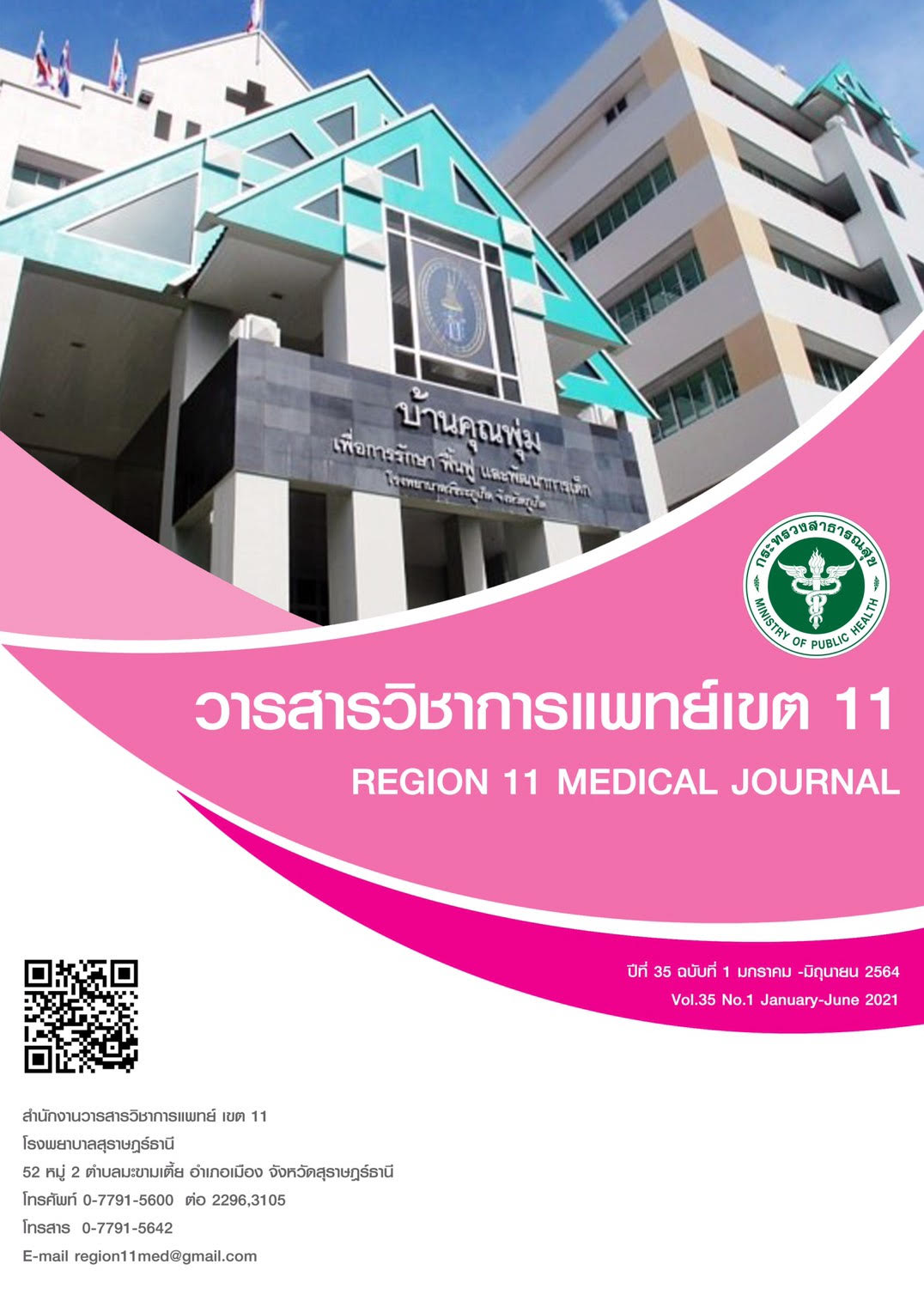Effectiveness of Implementing the Cognitive Behavior Therapy Multi-Channel Program Among Persons with Major Depressive Disorders, Bannadoem Hospital, Suratthani Province
Keywords:
depression disorder, the cognitive behavior therapy multi-channel programAbstract
Background: Past studies have found that major depressive disorder therapy in patients whose treatment plans were discontinuous had a higher recurrence rate than if treated with the cognitive behavior therapy multi-channel program. The cognitive behavior therapy multi-channel program may be an effective form of therapy for patients receiving continuous treatment to reduce depression.
Objectives: To evaluate effectiveness of implementing the cognitive behavior therapy multi-channel program among persons with major depressive disorders, Bannadoem Hospital, Suratthani.
Method: This quasi experimental study was conducted from April 2020 to June, 2020. The samples were evaluated depressive disorder level with 9-Item Thai Patient Health Questionnaire (Thai PHQ-9). The 34 samples with mild to moderate levels (5-8 score) of depression participated in the cognitive behavior therapy multi-channel program. The samples participated in a 9 times of the program, which comprised of Sookjai clinic therapy, phone therapy and home visiting therapy. Descriptive statistics including frequency percentage mean minimum maximum and standard deviation were used to analyze the data. Paired sample t-test was employed to compare the score depression before and after the program participation.
Results: Finding revealed that before participating to the cognitive behavior therapy multi-channel program the depressive disorder of all subjects were mild to moderate level (100.0%). After participated the cognitive behavior therapy multi-channel program in 2 weeks found that most of subjects were non depressive disorder (82.4%). The end of participated the cognitive behavior therapy multi-channel program reported all subjects were non depressive disorder (100.0%). The average depressive disorder score before and after participated the cognitive behavior therapy multi-channel program were 7.6 and 3.0 respectively with statistically significant (t=28.2, p<0.05).
Conclusion: It is argued from the current study that the cognitive behavior therapy multi-channel program makes the patients with depressive disorder likely to treated continuously and reduce their depression.
References
World Health Organization. Depression and Other Common Mental Disorders: Global Health Estimates; 2017.
กรมสุขภาพจิต. รายงานสถิติประจำปี. นนทบุรี: สำนักพัฒนาสุขภาพจิต กรมสุขภาพจิต; 2562.
โรงพยาบาลบ้านนาเดิม. รายงานสรุปผลการดำเนินงานโรงพยาบาลบ้านนาเดิม ปีงบประมาณ 2562.สุราษฎร์ธานี: โรงพยาบาลบ้านนาเดิม; 2562.
กรมสุขภาพจิต. แนวปฏิบัติทางคลินิกเพื่อการบำบัดทางสังคมจิตใจผู้ป่วยโรคซึมเศร้าสำหรับพยาบาล
จิตเวชในสถานบริการระดับตติยภูมิ. อุบลราชธานี: โรงพยาบาลพระศรีมหาโพธิ์; 2555.
Pearson, A., Wiechula, R., Court, A., Lockwood, C. The JBI Model of Evidence-Based Healthcare. International Journal of Evidence-Based Healthcare, 2005;3(8):207-15.
กรมสุขภาพจิต. แนวทางการดูแลเฝ้าระวังโรคซึมเศร้าระดับจังหวัด. (ฉบับปรับปรุงครั้งที่ 4). อุบลราชธานี: โรงพยาบาลพระศรีมหาโพธิ์; 2560.
Beck JS, Beck AT. Cognitive therapy: Basics and beyond: Guilford press New York; 1995.
ดาราวรรณ ต๊ะปินตา. ภาวะซึมเศร้า: การบำบัดและการให้การปรึกษาโดยการปรับความคิดและพฤติกรรม. เชียงใหม่: วนิดาการพิมพ์; 2556.
วัชรี แสงสาย, รังสิมันต์ สุนทรไชยา. ผลของการบำบัดทางความคิดและพฤติกรรมต่อภาวะซึมเศร้าและการทำหน้าที่ในผู้สูงอายุโรคซึมเศร้า. วารสารการพยาบาลจิตเวชและสุขภาพจิต. 2555;28(3):104-16.
บุษลักษณ์ สาฆะ. การบำบัดแบบปรับเปลี่ยนความคิดและพฤติกรรมในผู้ป่วยโรคซึมเศร้า [รายงานการศึกษาอิสระปริญญาพยาบาลศาสตรมหาบัณฑิต]. ขอนแก่น: มหาวิทยาลัยขอนแก่น; 2555.
Downloads
Published
How to Cite
Issue
Section
License
Copyright (c) 2021 Region11Medical Journal

This work is licensed under a Creative Commons Attribution-NonCommercial-NoDerivatives 4.0 International License.






